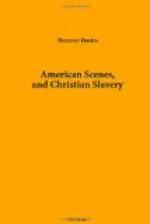This journey conducted us through New Brunswick, Elizabeth Town, Newark,—places associated with the name of David Brainerd, and often (a hundred years ago) the scenes of his toils and travels. But where are the descendants of those Indians on whose behalf he felt such intense solicitude? Alas! not a vestige of them is to be seen.
Having thus crossed New Jersey State, we came to New Jersey city, where we crossed a ferry to New York. After rather more than the usual amount of anxiety about baggage, &c., we reached the Planter’s Hotel a little after 10 at night.
Next morning I sallied forth to gaze, for the first time, at the wonders of New York. The state of the streets impressed me unfavourably. The pigs were in the enjoyment of the same unstinted liberty as at Cincinnati. Merchants and storekeepers spread their goods over the entire breadth of the causeway, and some even to the very middle of the street. Slops of all sorts, and from all parts of the houses, were emptied into the street before the front doors! The ashes were disposed of in a very peculiar manner. Each house had, on the edge of the parapet opposite, an old flour-barrel, or something of the sort, into which were thrown ashes, sweepings, fish-bones, dead rats, and all kinds of refuse. A dead rat very frequently garnished the top of the barrel. This was the order of things, not in small by-streets only, but also in the very best streets, and before the very best houses. The pavement too, even in Broadway, was in a very wretched state.
I made for No. 150, Nassau-street, where the Tract Society, the Home Missionary Society, and the Foreign Missionary Society have their rooms. To some parties in that house I had introductions. The brethren connected with those societies treated me with great kindness and cordiality, and made me feel as though I had been in our own missionary rooms in Blomfield-street. By their aid I obtained private lodgings, in a good situation and in good society.
The landlady was a Quaker, with half-a-dozen grown-up daughters. Our fellow-lodgers consisted of the Rev. A.E. Lawrence, Assistant-Secretary of the American Home Missionary Society (who had a few months before become the landlady’s son-in-law); the Rev. Mr. Martyn, and his wife, a woman of fine talents, and editor of “The Ladies’ Wreath;” the Rev. Mr. Brace, an editor in the employ of the Tract Society; Mr. Daniel Breed, M.D., a Quaker, and principal of a private academy for young gentlemen (also the landlady’s son-in-law); Mr. Oliver Johnson, a sub-editor of the Daily Tribune, and a well-known Abolitionist; and Mr. Lockwood, a retired grocer,—who, having gained a small independence, was thus enjoying it with his youthful wife and child in lodgings.




